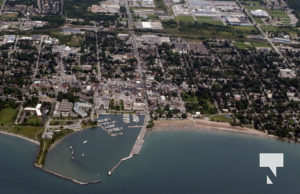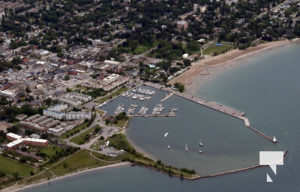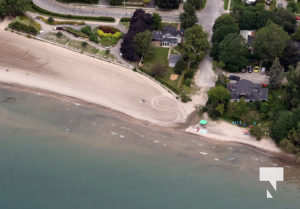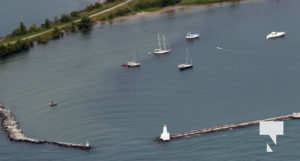Cecilia Nasmith/Today’s Northumberland
An astounding 13 speakers had delegation status at the June 4 Cobourg council meeting, 12 of them addressing the Waterfront User Needs Assessment and Detailed Design Plan.
The speakers took up the first two and a half hours of what proved to be a six-hour council meeting, almost all of them presenting objections (and many of the objections dealing with the plan to expand marina slips into the west harbour).

Council decided to delay a motion to accept the report to July 3. Anticipating more presentations in the interim, director of culture and recreation Dean Hustwick – having sat through all the presentations, as well as through the many public-engagement sessions the consultants hosted – felt compelled to make two points in an interview this week.
One – the objections are premature. Council engaged the consultants to draw on their expertise and experience to conduct an exhaustive consultation, and then put forward the plan they thought was best for the town. Should council accept the plan July 3, it would commit the town to absolutely nothing. Any and every element of the plan can be isolated, debated, budgeted, accepted, implemented, disregarded or even discarded.

Two – some of the points the presenters made were in error, such as the assertion that Cobourg has more marina slips per capita than Kingston. Hustwick investigated this one, and found that the calculation was not only based on a miscount, but also did not take into account Kingston’s two yacht clubs and the slips they represent.
Hustwick recognized almost all the presenters (and almost all the organizations they represent) from their participation in a year and a half of engagements arranged by the consultants, “more than the community has ever done before on any other planning process,” he said.
“To our delight, the community absolutely joined in and spent an incredible amount of time collectively contributing to public meetings, completing questionnaires, filling out detailed surveys.”
This kind of commitment is reason to celebrate, Hustwick declared, but not everyone will be in agreement with the results.
“I think what’s important is to be able to recognize what the broad community’s interests and wishes are. And ultimately, that’s what the consultants have spent so many months reviewing in great detail, and incorporating those broad wishes into their recommendations,” he said.
“Like any public process, not everyone will agree with all the recommendations. Not all the recommendations will align with all individuals and organizations and their mandates and objectives. But the responsibility of any government is to pursue what is best for the greatest number of people and the long-term success of the community.”
The objective of the consultants and municipal staff is to bring forward factual information and well-thought-out recommendations based on community input, Hustwick said.
“I know some of these individuals and groups have very emotional attachments to some of these issues, but our job is to provide council with facts.”

The plan was based on a 24-year roll-out, he said, and a lot can change over 24 years.
“This is one plan amongst many. The town has many priorities and, in every year’s budget process, council needs to consider, review, debate all the different priorities of the municipality,” Hustwick pointed out.
“On average, the consultant said, $1-million a year should take care of it. Are we realistically going to have $1-million a year for all these things? Perhaps not. But that will be up to council each year through the budget process.”
One Cobourg resident pleaded for council to stop treating the waterfront as an asset to be exploited, but Hustwick pointed out a broad category of expense that will claim much of the municipal budget in years to come – asset management.

This is a provincial initiative that is gaining acceptance among municipalities, and has also begun in Cobourg. Part of the process is an assessment of municipal assets (such as the marina) with an eye to their upkeep and eventual timely replacement. One assessment coming up soon is that of the east pier, whose condition has forced its closure for safety purposes. A complete assessment of the east pier will cost $50,000 just to learn what work has to be done – before the first dollar is even spent on its rehabilitation.
“We have to look at the whole harbour in several different ways,” Hustwick said.
“It is a permanent asset of this community which needs to be maintained, and will be very costly in the years ahead. The harbour, the waterfront is a very significant economic engine for this community. It draws a lot of people into the community and generates a lot of direct and indirect spending.”
Sources of direct revenue from the waterfront are predominantly the campground and marina, Hustwick said, with parking also generating about $170,000 a year.

The canteen generates $20,000, but the town spends $50,000 a year to clean the washrooms.
“That building loses $30,000 a year,” he said.
“The recommendation was, when you have this many people come to town, we have the potential to leverage that kind of attendance.”
The new Courtyard Summer Series and the floating playground that should be open by the July 1 weekend are examples he has hopes for. But it must not be forgotten that the waterfront is an important economic engine, he reiterated, and that annual maintenance costs and future capital-upgrade costs will be essential to maintain this infrastructure.
(From consultants’ surveys: 81% of residents responding indicated the need for minor [44%] or major [37%] improvements to the waterfront.)
“You have to look at who is paying for what,” Hustwick said.
“Taxpayers will absolutely have to pay for that harbour as long as it exists, so how can we offset the burden on taxpayers? Through attraction and user fees.
“The problem with the harbour is, the only real user fees are paid for by boaters. The only real revenue source in the harbour is through the marina through slip rental, storage, boat lifting, hull washing, things like that.”
There are smaller sources of revenue, but other user fees are rare. The Survivor Thrivers Breast Cancer Dragon Boat Team, for example, pays no user fees and is given one of the marina slips for its dragon boats.

The Cobourg Dragon Boat and Canoe Club pays about $5,200 a year.
The Cobourg Yacht Club pays property taxes and storage and has some slips in the marina (for total revenues of about $10,000), and they get the use of the west wall of the centre pier to dock the occasional boat.
Add that up, Hustwick said, and see how it compares to $676,000 in revenue from boaters using the marina.
A misconception he often hears is that the marina loses money and is subsidized by taxpayers and does not make nearly enough to pay for its long-term capital improvements.
The town provided all financials to the consultants, and they concluded that the marina has been paying for all operating expenses for the harbour with money left over to subsidize taxpayers. That profit can handily provide for the travelift that the consultants recommended purchasing, Hustwick said.
He heard a lot of lobbying at council to preserve the natural setting in the west sector, but he argues that the harbour is a man-made asset that was built 150 years ago for commercial purposes (as opposed to the recreational craft that make use of it today).
In its time, it has served as a major commercial port for trading ships of 50-ton capacity or more. For a half-century, it also hosted a car ferry that shuttled between Cobourg and New York – each year it moved 70,000 passengers and 12,800 railroad cars of coal.

A diagram that was part of the Cobourg Parks Master Plan (adopted in 2013) agreed that most of the west harbour, along with the centre pier and east pier, falls under the Urban Waterfront Experience designation. West of there – basically the west headland and westward – is designated Natural Waterfront Experience.
There is no conflict with the consultants here, he pointed out. Their recommendation is to keep the west headland a natural area open only to foot traffic.
(From consultants’ surveys: 73% of residents responding agreed that an active harbour is important to the successful development of the waterfront.)
The threat of slips expanding into the relatively quieter west harbour is causing much distress to the non-motorized users of the harbour – the paddlers of all ages who are part of the Survivor-Thrivers or Dragon Boat clubs. But Hustwick pointed out that, even with the new slips, the marina would account for only 24% of the harbour area.
“Everyone has to compromise,” he stressed.
“You can’t have everything you want. It imposes your personal desires, opinions and objectives, and intrudes on the capacity of the town to meet the objectives and needs of other users.
“The Dragon Boaters and Survivor-Thrivers claim additional boat slips will prevent them from operating. The consultants have said they believe firmly by working together and scheduling users in the harbour – as we do everything else – we can not only continue to support all these uses but, in fact, grow them.
“I believe by working collaboratively with the town, we will be able to help these organizations grow and improve their organizational strength and their ability to offer services to the public. I firmly and adamantly believe we can do that, but it would require collaboration and a willingness to share.”
Presenters insisted that the idea of slips west of centre pier had been voted down by a previous council. In fact, he said, councillors decided at the time to let the matter go until a new council could be elected. Now, at the end of that subsequent term of council, the idea is still far from any potential implementation. And the matter arises again because it was a suggestion of the consultants, not of the town.

While some presenters spoke of a decline in the boating industry, all research he has seen concludes the opposite. And the marina is experiencing waiting lists and high demand.
“More boating slips, more profit,” Hustwick figures.
(From consultants’ surveys: 55% of residents said the town should facilitate investment in the marina, if revenues generated as a result are used to finance improvements to maintenance of the harbour and the waterfront for other uses/users.)
The town has gone back to marina figures to calculate based on a new model of separating revenue and expenses into distinct business units for greater transparency and accountability. Using the current accounting approach, more than $540,000 in expenses has been paid by the marina – essentially by those boaters – that would otherwise have been tacked on to taxes. And at the end of 2017, the marina reserve account stood at $351,247.
With 71 serviced RV sites and five unserviced tent sites, the campground has generated a profit of $961,096 over the past six years, with some $881,000 transferred to the town’s general revenue to help keep taxes lower.

Hustwick is puzzled by the occasional aversion to tourism that he sees, especially since those grand old heritage mansions the town takes such pride in were often built as summer-vacation homes for American millionaires in the 19th century. Vistors generate revenue through parking, canteen sales, sports tournaments, community events. There are benefits to local businesses, local organizations, and to the town.
(From consultants’ surveys: 80% of residents responding indicated that tourism is or will be important to the town’s economy.)
Just looking at the economic impact from the marina alone, Touristics calculates that figure at $12.2-million in direct expenditures, insurance, supplies, repairs, groceries, restaurants, retail sales, and tourist attractions and events.
Touristics offered a further calculation – the average transient boater spends an average of $211.30 per person for an overnight stay, and the average stay is two nights.
Hustwick said you can’t lose sight of the fact that the enthusiastic response to their community engagement exercises gave the consultants a good picture of what the community wants. While someone addressing council has a right to his or her view, he said, it very well may not represent a majority opinion.
“It doesn’t detract from the fact that a large number of residents from this community spent a great deal of time contributing their opinions. The report reflects their opinions,” he said.
“So many communities across the province and the country are stagnating and suffering – no economic growth, no population growth, businesses suffer, businesses close. There just isn’t that local economic strength to sustain.

“We have seen communities die off and disappear. Fortunately, Cobourg is on the other side of the spectrum. We have always been a popular destination. The vast majority of people who end up moving here were probably here first as visitors.”
Hustwick said it’s also important to remember that the debate over whether council accepts the report should be a separate matter from any debate over the recommendations it contains.
“It’s simply presenting the consultants’ final report for council to adopt and move forward. The recommendations will go through the annual budget process. There will be plenty of time to decide which recommendations to agree with and what not to address.”
Though people still express opposition opinions, Hustwick is confident enough in the consultants’ public-engagement process to be sure that their report reflects the majority opinion.
“When you look at all the data, it’s pretty consistent in direction – leverage the visitors, develop new opportunities to leverage those visitors, and generate funds to pay for our assets.”
























